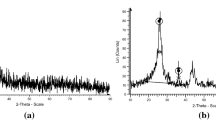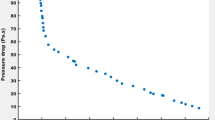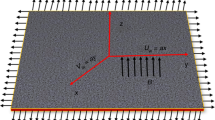Abstract
Nanofluid is a colloidal solution of nano-sized particles which enhances the thermal performance, but their viscosity put the limitation for their effective use in many industrial applications as it adversely affects the pumping power. In the present work, response surface methodology (RSM) with three-level factorial design and desirability approach was utilized to optimize thermal conductivity and viscosity of TiO2-water nanofluid simultaneously. In this regard, the impact of temperature of nanofluid (T), the concentration of nanoparticle in base fluid (ϕ) and diameter of nanoparticle (dp) on the viscosity (ν) and thermal conductivity (k) of TiO2-water nanofluid was studied. According to the results, the predicted values were in smart agreement with the experimental data. The maximum percentage error was found to be only 1.67 and 8.23 for viscosity and thermal conductivity of nanofluid, respectively, which demonstrate the preciseness of the applied model. The most dominant factors which affect the viscosity and thermal conductivity of nanofluids were found to be the temperature, concentration and the diameter of nanoparticles. The optimized values of the temperature, concentration of nanoparticles and diameter of nanoparticle obtained according to desirability approach for multi-objective optimization were T = 60 °C, ϕ = 1.41 vol% and dp = 60 nm.











Similar content being viewed by others
References
Sergis A, Hardalupas Y. Anomalous heat transfer modes of nanofluids: a review based on statistical analysis. Nanoscale Res Lett. 2011;6:391. https://doi.org/10.1186/1556-276x-6-391.
He Y, Men Y, Zhao Y, Lu H, Ding Y. Numerical investigation into the convective heat transfer of TiO2 nanofluids flowing through a straight tube under the laminar flow conditions. Appl Therm Eng. 2009;29(10):1965–72.
Yu W, France DM, Routbort JL, Choi SUS. Review and comparison of nanofluid thermal conductivity and heat transfer enhancements. Heat Transfer Eng. 2008;29(5):432–60. https://doi.org/10.1080/01457630701850851.
Ren Y, Xie H, Cai A. Effective thermal conductivity of nanofluids containing spherical nanoparticles. J Phys D Appl Phys. 2005;38(21):3958.
Mintsa HA, Roy G, Nguyen CT, Doucet D. New temperature dependent thermal conductivity data for water-based nanofluids. Int J Therm Sci. 2009;48(2):363–71.
Chandrasekar M, Suresh S, Bose AC. Experimental investigations and theoretical determination of thermal conductivity and viscosity of Al2O3/water nanofluid. Exp Therm Fluid Sci. 2010;34(2):210–6.
Papari MM, Yousefi F, Moghadasi J, Karimi H, Campo A. Modeling thermal conductivity augmentation of nanofluids using diffusion neural networks. Int J Therm Sci. 2011;50(1):44–52.
Hosseini SM, Moghadassi A, Henneke DE. A new dimensionless group model for determining the viscosity of nanofluids. J Therm Anal Calorim. 2010;100(3):873–7.
Chang H, Jwo C, Fan P, Pai S. Process optimization and material properties for nanofluid manufacturing. Int J Adv Manuf Technol. 2007;34(3):300–6.
Gupta SM, Tripathi M. A review of TiO2 nanoparticles. Chin Sci Bull. 2011;56(16):1639–57.
Naphon P, Thongkum D, Assadamongkol P. Heat pipe efficiency enhancement with refrigerant-nanoparticles mixtures. Energy Convers Manag. 2009;50(3):772–6.
Godson L, Raja B, Mohan Lal D, Wongwises S. Enhancement of heat transfer using nanofluids–an overview. Renew Sustain Energy Rev. 2010;14(2):629–41.
Kulkarni DP, Vajjha RS, Das DK, Oliva D. Application of aluminum oxide nanofluids in diesel electric generator as jacket water coolant. Appl Therm Eng. 2008;28(14-15):1774–81.
Suganthi KS, Leela Vinodhan V, Rajan KS. ZnO-propylene glycol-water nanofluids with improved properties for potential applications in renewable energy and thermal management. Colloids Surf A. 2016;506:63–73.
Chieruzzi M, Cerritelli GF, Miliozzi A, Kenny JM. Effect of nanoparticles on heat capacity of nano-fluids based on molten salts as PCM for thermal energy storage. Nanoscale Res Lett. 2013;8:448.
Esfe MH, Saedodin S, Bahiraei M, Toghraie D, Mahian O, Wongwises S. Thermal conductivity modeling of MgO/EG nanofluids using experimental data and artificial neural network. J Therm Anal Calorim. 2014;118:287–94.
Bashirnezhad K, Bazri S, Safaei MR, Goodarzi M, Dahari M, Mahian O, Dalkılıça AS, Wongwises S. Viscosity of nanofluids: a review of recent experimental studies. Int Commun Heat Mass Transf. 2016;73:114–23.
Putra N, Roetzel W, Das S. Natural convection of nano-fluids. Heat Mass Transfer. 2003;398:775–84.
Wang X, Xu X, Choi SUS. Thermal conductivity of nanoparticle-fluid mixture. J Thermophys Heat Transf. 1999;13:474–80.
Zhang X, Gu H, Fujii M. Experimental study on the effective thermal conductivity and thermal diffusivity of nanofluids. Int J Thermophys. 2006;27:569–80.
Sonawane SS, Khedkar RS, Wasewar KL. Effect of sonication time on enhancement of effective thermal conductivity of nano TiO2–water, ethylene glycol, and paraffin oil nanofluids and models comparisons. J Exp Nanosci. 2015;10:310–22.
Duangthongsuk W, Wongwises S. Comparison of the effects of measured and computed thermophysical properties of nanofluids on heat transfer performance. Exp Thermal Fluid Sci. 2010;34:616–24.
Esfe MH, Saedodin S, Naderi A, Alirezaie A, Karimipour A, Wongwises S, et al. Modeling of thermal conductivity of ZnO-EG using experimental data and ANN methods. Int Commun Heat Mass Transf. 2015;63:35–40.
Sepyani K, Afrand M, Hemmat Esfe M. An experimental evaluation of the effect of ZnO nanoparticles on the rheological behavior of engine oil. J Mol Liq. 2017;236:198–204.
Shu R, Gan Y, Lv H, Tan D. Preparation and rheological behavior of ethylene glycol-based TiO2 nanofluids. Colloids Surf A. 2016;509:86–90.
Rostamian SH, Biglari M, Saedodin S, Esfe MH. An inspection of thermal conductivity of CuO-SWCNTs hybrid nanofluid versus temperature and concentration using experimental data, ANN modeling and new correlation. J Mol Liq. 2017;231:364–9.
Esfe MH, Ahangar MRH, Rejvani M, Toghraie D, Hajmohammad MH. Designing an artificial neural network to predict dynamic viscosity of aqueous nanofluid of TiO2 using experimental data. Int Commun Heat Mass Transf. 2016;75:192–6.
Yahya SM, Anwer SF, Sanghi S. Variable expansivity: a key changing parameter in modeling of thermal conductivity of nanaofluid. Nanosci Nanotechnol Lett. 2014;6(10):942–6.
Ansari S, Hussain T, Yahya SM, Chaturvedi P, Sardar N. Experimental investigation of viscosity of nanofluids containing oxide nanoparticles at varying shear rate. J Nanofluids. 2018;7(6):1075–80.
Box GE, Draper NR. Empirical model-building and response surfaces. New York: Wiley; 1987.
Sadollah A, Ghadimi A, Metselaar IH, Bahreininejad A. Prediction and optimization of stability parameters for titanium dioxide nanofluid using response surface methodology and artificial neural networks. Sci Eng Compos Mater. 2013;20(4):319–30.
Karimi H, Yousefi F. Application of artificial neural network–genetic algorithm (ANN–GA) to correlation of density in nanofluids. Fluid Phase Equilib. 2012;336:79–83.
Montazer E, Erfan S, Yarmand H, Chowdhury ZZ, Dahari M, Kazi SN, Badarudin A. Development of a new density correlation for carbon-based nanofluids using response surface methodology. J Therm Anal Calorim. 2018;132:1399–407.
Esfe MH, Firouzi M, Rostamian H, Afrand M. Prediction and optimization of thermophysical properties of stabilized Al2O3/antifreeze nanofluids using response surface methodology. J Mol Liq. 2018;261:14–20.
Danish M, Ginta TL, Habib K, Carou D, Rani AMA, Saha BB. Thermal analysis during turning of AZ31 magnesium alloy under dry and cryogenic conditions. Int J Adv Manuf Technol. 2017;91:2855–68.
Keshtegar B, Mert C, Kisi O. Comparison of four heuristic regression techniques in solar radiation modeling: Kriging method vs RSM, MARS and M5 model tree. Renew Sustain Energy Rev. 2018;81:330–41.
Yousuff C, Danish M, Ho E, Kamal Basha I, Hamid N. Study on the optimum cutting parameters of an aluminum mold for effective bonding strength of a PDMS microfluidic device. Micromachines. 2017;8:258.
Chabbi A, Yallese MA, Meddour I, Nouioua M, Mabrouki T, Girardin F. Predictive modeling and multi-response optimization of technological parameters in turning of Polyoxymethylene polymer (POM C) using RSM and desirability function. Measurement. 2017;95:99–115.
Keshtegar B, Heddam S. Modeling daily dissolved oxygen concentration using modified response surface method and artificial neural network: a comparative study. Neural Comput Appl. 2017;10:10. https://doi.org/10.1007/s00521-017-2917-8.
Yang P, Chen H, Liu Y. Application of response surface methodology and desirability approach to investigate and optimize the jet pump in a thermoacoustic Stirling heat engine. Appl Therm Eng. 2017;127:1005–14.
Mohammed BS, Khed VC, Nuruddin MF. Rubbercrete mixture optimization using response surface methodology. J Clean Prod. 2018;171:1605–21.
Author information
Authors and Affiliations
Corresponding author
Additional information
Publisher's Note
Springer Nature remains neutral with regard to jurisdictional claims in published maps and institutional affiliations.
Rights and permissions
About this article
Cite this article
Danish, M., Yahya, S. & Saha, B.B. Modelling and optimization of thermophysical properties of aqueous titania nanofluid using response surface methodology. J Therm Anal Calorim 139, 3051–3063 (2020). https://doi.org/10.1007/s10973-019-08673-z
Received:
Accepted:
Published:
Issue Date:
DOI: https://doi.org/10.1007/s10973-019-08673-z




